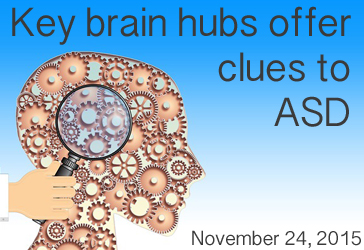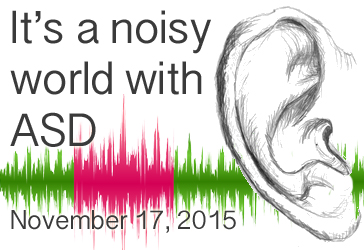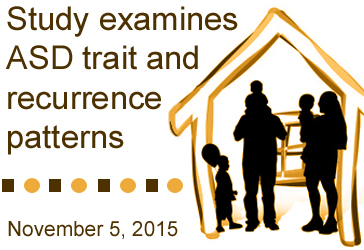Archives
November, 2015
Select a different month in the archive
Brain Organization Ages Differently in Autism
By Chelsea E. Toledo, M.A. on November 24, 2015

Background: The human brain is comprised of an intricate network of interconnected regions. Of the hundreds of regions in the human brain, there exists highly connected central regions--or hubs--that link sparsely populated peripheral regions of the brain. Known as the “rich club,” these areas are thought to play key role in integrating information across the brain. Research has suggested that their connectivity may be different in people with autism spectrum disorder (ASD).
What’s New: On November 5, 2015, the journal Scientific Reports explored how organization of the rich club hubs differed in people with ASD versus those with typical development as they aged. The researchers compared brain connectivity data of children between the ages of 9 and 13 to that of a group of adolescents between the ages of 13 and 18. The results of their analysis indicated that organization of rich club hubs in the brain increased as the 36 typically developing children and adolescents aged, but that the same progress wasn’t observed in the 45 children and adolescents with ASD.
Why it’s important: This study adds to the findings suggesting that rich club organization underlies cognition, and that dysfunction in that organization could play a role in certain neurodevelopmental disorders. Future studies could illuminate the precise role of rich club organization and pinpoint how puberty affects its development.
Help me understand :
| Source(s) : |
| Tweet |
Neural Basis of Noise Overload in ASD Explained
By Shana R. Spindler, PhD on November 17, 2015

Background: About 90 percent of people with Autism Spectrum Disorder (ASD) experience some form of sensory-related symptoms, such as over or under sensitivity to sights, sounds, and even tastes (reviewed in Geschwind, 2009). Researchers have hypothesized that an abnormal adaptation to sensory stimuli may underlie the social and communication difficulties seen in ASD.
What’s new: On November 5, 2015, Scientific Reports published a study examining loudness adaptation in 20 adults with ASD and 20 neurotypical individuals. The researchers found that adults with ASD were slower and less able to adapt to a continuous, low-level sound than neurotypical adults.
In the study, the participants listened to a soft, constant sound for several minutes and recorded the perceived volume of the sound at specific time intervals. While the neurotypical individuals said the sound decreased by about 50 percent in volume over time—even though the volume of the sound was unchanged—adults with ASD perceived a mere 20 percent reduction. In contrast, adaptation to loud sounds with intermittent disruptions was similar between neurotypical adults and those with ASD.
Why it’s important: The adaptation to constant, quiet sounds is thought to involve a different part of the brain than adaptation to loud, interrupted sounds—think of the hum of a refrigerator versus a fire alarm. Therefore, this is the first study to show that noise overload in ASD may stem from a neural inability to adapt to certain sound types. Interestingly, for individuals with ASD who reported using coping strategies, their adaptive responses were closer to neurotypical individuals.
Help me understand :
| Source(s) : |
| Tweet |
How People with ASD See the World Differently
By Chelsea E. Toledo, M.A. on November 10, 2015

Background: Autism spectrum disorder (ASD) affects three major and inter-related areas: communication, social interaction, and behavior. Research has shown that people with the disorder read faces and other social cues differently than their typically developing peers, which could contribute to the observed behavioral symptoms in ASD.
What’s New: On November 4, 2015, the journal Neuron published a study exploring how general gaze – not just at faces – may differ in individuals with ASD. The researchers showed 700 naturalistic images capturing common daily scenarios to 20 people with ASD and average IQ. Using an eye-tracking device to follow their gaze, they found that, when compared to 19 peers with typical development, the ASD group spent more time focused on the center of an image, even if there was no object in the image’s center. They also found that the ASD group took longer to focus on faces in the images, but were quicker than their typically developing peers to focus on mechanical objects.
Why it’s important: This study suggests that differences in gaze observed in people with ASD is not limited to reading faces, but represents a larger perceptive difference. Larger studies are needed to further define these differences in atypical visual processing in ASD. The eye tracking methodology holds much promise as a non-behavioral early ASD diagnostic marker.
Help me understand :
| Source(s) : |
| Tweet |
Four Key Trends Found for ASD Traits and Recurrence
By Shana R. Spindler, Ph.D. on November 5, 2015

Background: Several studies suggest that in families containing one or more individuals with Autism Spectrum Disorder (ASD), non-diagnosed members have increased presence of ASD-related traits. However, little is known about the prevalence or nature of these traits among the siblings in families where multiple members have ASD.
What’s new: On October 27, 2015, the journal Molecular Autism published a study exploring autism symptom pattern and recurrence in families with children on the spectrum. The researchers compared data for over 5500 siblings from the Autism Interactive Network. By examining single versus multiple incidence of ASD in a family, as well as the affected gender, the researchers discovered four key trends:
- Non-diagnosed children who have more than one sibling with autism possess an increased and specific pattern of autistic traits—namely resistance to change and restricted interests.
- Children with ASD from multiple incidence families are less symptomatic than those from single incidence families.
- A history of language delay with atypical speech is a risk factor for both social and restrictive/repetitive behavior symptoms in children not diagnosed with ASD from single or multiple incidence families.
- Males who are born into a multiple incidence family including at least one female with ASD are at a greater risk for possessing autistic traits. Likewise, families containing any number of females with ASD have greater recurrence risk for future children.
Why it’s important: This study may useful for the genetic counseling of families with ASD who are considering having another child, or for parents who are worried about their children’s risk of having a child with ASD. The study supports the idea that females require a greater risk factor burden before entering into an ASD diagnosis, making it more likely that males in the same family will have more severe autistic traits. It’s important to note, though, that currently there is no way to predict if anyone will or will not have a child with ASD or ASD-related traits.
Help me understand :
| Source(s) : |
| Tweet |

